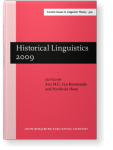On the reconstruction of experiential constructions in (Late) Proto-Indo-European
Vit Bubenik | Memorial University of Newfoundland, Canada
In this paper I will attempt to reconstruct the (Late) PIE syntax of experiential constructions for three classes of verbs: in (1) and (2) for verbs of cognition and perception, in (3) verbs denoting changes in bodily states, and in (4) verbs of deontic and epistemic modality. In (5) I will make some proposals regarding typology and syntax of experiential constructions in terms of several diachronic layers. I will also try to ascertain whether we can reconstruct the so-called ‘oblique subject’ typology for the (Late) PIE and, if not, at which intermediate period in its trajectory to the current state of affairs we can discern the appearance of oblique (or rather ‘secondary’) subjects. On the whole, I will be more preoccupied with morphological, semantic and pragmatic properties of the experiential constructions in Ancient IE (Greek, Latin, Sanskrit, Gothic, Old Slavic) and Modern Germanic, Baltic and Slavic languages than with the issue of ‘subjecthood’ in terms of formal syntax. In conclusion, I will submit that the cognitive approach presents a number of important correctives to more formal syntactic approach into the typology and diachrony of experiential constructions across the spectrum of Indo-European languages.
Cited by (2)
Cited by two other publications
Halevy, Rivka
2022.
What makes the dative-experiencer construction in Modern Hebrew different from its counterparts in European languages?.
STUF - Language Typology and Universals 75:3
► pp. 379 ff.

Dahl, Eystein & Chiara Fedriani
2012.
The Argument Structure of Experience: Experiential Constructions in Early Vedic, Homeric Greek and Early Latin1.
Transactions of the Philological Society 110:3
► pp. 342 ff.

This list is based on CrossRef data as of 23 july 2024. Please note that it may not be complete. Sources presented here have been supplied by the respective publishers.
Any errors therein should be reported to them.
